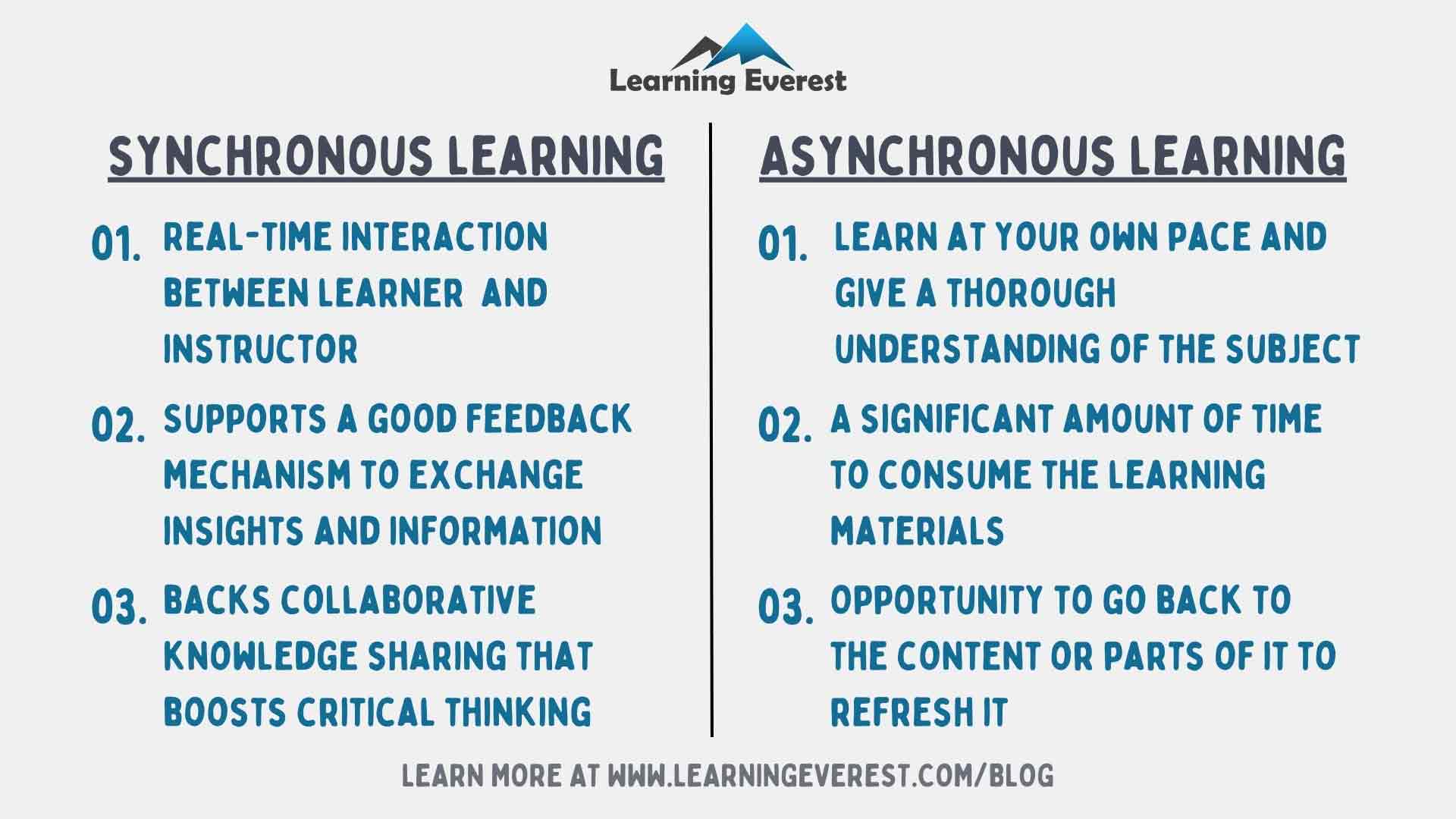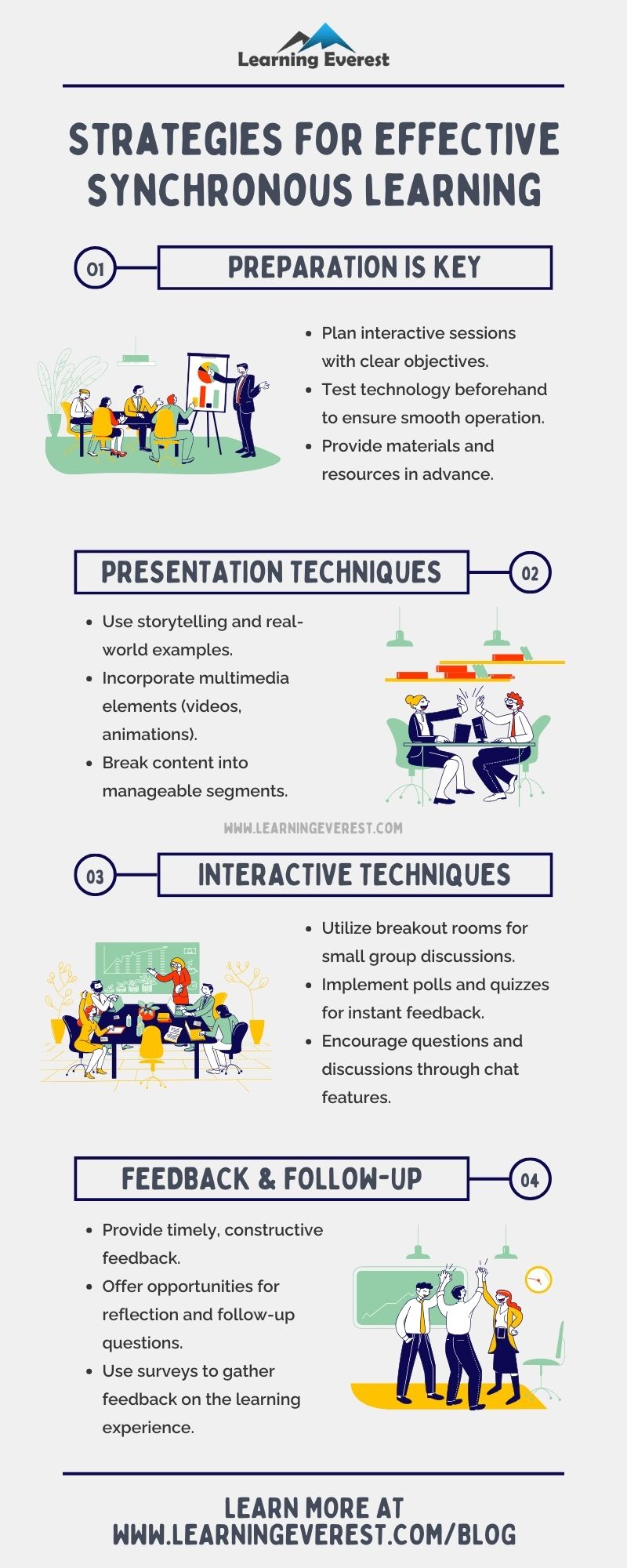In this blog, we delve deep into knowing what is synchronous learning and how you can leverage synchronous learning to train your remote employees. Let’s begin!
Table of Contents
- What is synchronous learning?
- How is it Different from Asynchronous Training?
- Is Synchronous Learning Good for Remote Corporate Training?
- How Can Organizations Ensure Effective Synchronous Learning with an L&D Platform like Learning Everest?
- Infographic
- Knowledge Check!
- Frequently Asked Questions (FAQs)
- 1. What is synchronous learning?
- 2. Why is synchronous learning important?
- 3. What is an example of a synchronous class?
What is synchronous learning?
The word “synchronous” literally suggests at the same time. Synchronous learning is a training method that allows learners to connect and learn the same thing simultaneously. In synchronous learning, learners and instructors are engaged in course content using online platforms. It is mainly an instructor-led learning and development program, which can be face-to-face (ILT) or virtual (VILT).
Employees generally tend to be lenient towards synchronous learning. Efficient synchronous training will have an intelligent feedback loop that simplifies training modules for your employees, clients, and other stakeholders. An L&D can support synchronous learning using multiple techniques like:
- Virtual classrooms
- Online degree programs
- Audio or video content feeds
- Instant chat
- WebEx or webinars
If you have a team working remotely or in a hybrid manner, an L&D platform can use all these techniques to ensure your employees get face-to-face sessions through synchronous training.
However, to understand what kind of remote training suits your employees the most, it is best to have a learners’ assessment first. You will find different learner needs, learning preferences, and training needs. Based on the findings of your assessments, you may choose either synchronous or asynchronous training. Now that you know what is synchronous learning let’s see how it is different from asynchronous learning.
How is it Different from Asynchronous Training?

How is Synchronous Different from Asynchronous Training?
Now…
Is Synchronous Learning Good for Remote Corporate Training?
Yes, synchronous learning is one of the appropriate measures that your organization could take. Here is why:
1. It’s suitable for all types of teams
With remote work, it is essential to find training programs that work virtually and in the office. Using technology, remote synchronous training can be done online and in person, making it flexible and suitable for all workplace teams. You can provide consistent formal training to your employees, thus ensuring that they receive the same knowledge through their trainer/instructor. Instructors can use different tools and techniques like videos, and rich graphical content feeds as part of learning lessons to make learning more efficient.
2. Builds communities faster
You can connect remote learners with your company by providing them with the same learning environment and experience. When learners are learning together simultaneously, connections can be formed instantly, which builds a community and creates a happy workplace culture. A fantastic workplace culture is essential because those working in a suitable culture are happy!
3. Promotes psychological safety within teams
Learning together with your peers promotes trust, open communication, and honesty, promoting psychological safety. When employees experience psychological safety, they start believing that the workplace they are in is safe, which allows for risk-taking and more innovative idea expression. By fostering synchronous learning, ideas can be freely communicated, and help is given, which means psychological safety is kept and a strong team can be built.
4. Improves motivation to learn
Seeing all your peers gathered together and learning about the same thing can inspire and motivate employees. It creates a sense of harmony and a feeling that everyone is working towards the same goal, making members more motivated to learn and engage. Therefore, not only does the engagement become higher in synchronous training, but it also improves engagement within a team in the long run. This is because team members see it as an obvious investment for their future, which means they are likely to be more engaged with the organization and, as a result, become more productive, profitable, safer, and healthier.
5. Increases completion rate
Unless careful measures are in place to track learning progress, asynchronous learning can offer a few employees a way to bypass the training and carry on with something they see as important, especially when it comes to training remote employees. Therefore, synchronous learning has a higher completion rate and can, therefore, be more effective.
6. Stops remote workplace isolation
It is hardly surprising that working remotely can feel very lonely. And, even in the busiest offices, working alone at a desk all day, every day, can lead to loneliness. You are allowing your team to come together and interact by offering real-time and in-person training. This encourages new peer relationships and, as a result, can work to improve workplace isolation.
7. Raises opportunity for immediate feedback
A smile can say a hundred words, and so can an exhausted yawn or a frustrated eye-roll. One significant benefit of synchronous learning is that it allows for real-time feedback and follow-ups. The instructor can read the room and get a fair idea of whether employees are engaged and motivated by the session or not. They can also communicate their performance levels through an instant feedback loop, which can constantly motivate your employees.
Sounds tough?
Not with a suitable L&D platform that offers blended learning!
How Can Organizations Ensure Effective Synchronous Learning with an L&D Platform like Learning Everest?
After all the above discussions, it is impossible to disregard the significance of synchronous online workplace training completely. An L&D platform like Learning Everest supports blended learning so that your organization can learn new capabilities and re-learn old skills using new training approaches.
Learning Everest is a smart L&D that can undertake group exercises for your company, such as onboarding, safety training, compliance training, customer training, and cultural sensitivity training in the workplace. Learning Everest is designed with exciting features that promote a holistic learning experience in organizations. To name a few,
- We create eye-catching Virtual Instructor-led courses, including Presentations, FGs, and PGs.
- We have a team of instructional designers who can convert your raw and dry topics into eye-catching, attractive, and engaging content.
- Learning Everest specializes in creating immersive and engaging custom eLearning courses using various rapid authoring tools.
- We create courses that are best suited for any mobile device.
- Can you produce video courses and host them on your LMS, Udemy, Teachable, or other platforms? We help you create these courses.
- If you want to share your learning content with your global audience, we localize the courses, too, to make them more relevant.
- We also excel at creating gamification, which promotes fun and engaging learning to improve knowledge retention.
- We also create micro-learning courses to make complex content simple to understand and easy for employees to absorb.
Talk to our team to experience the features of our learning and development platform.
Infographic

Strategies for Effective Synchronous Learning
Knowledge Check!
Frequently Asked Questions (FAQs)
1. What is synchronous learning?
Synchronous learning is a training method that allows learners to connect and learn the same thing simultaneously.
2. Why is synchronous learning important?
Learning together promotes trust, open communication, and honesty, promoting psychological safety. By fostering real-time learning, ideas can be freely shared, and support is given, meaning psychological safety is reinforced and a strong team is built.
3. What is an example of a synchronous class?
An example of a synchronous class is a live webinar.





